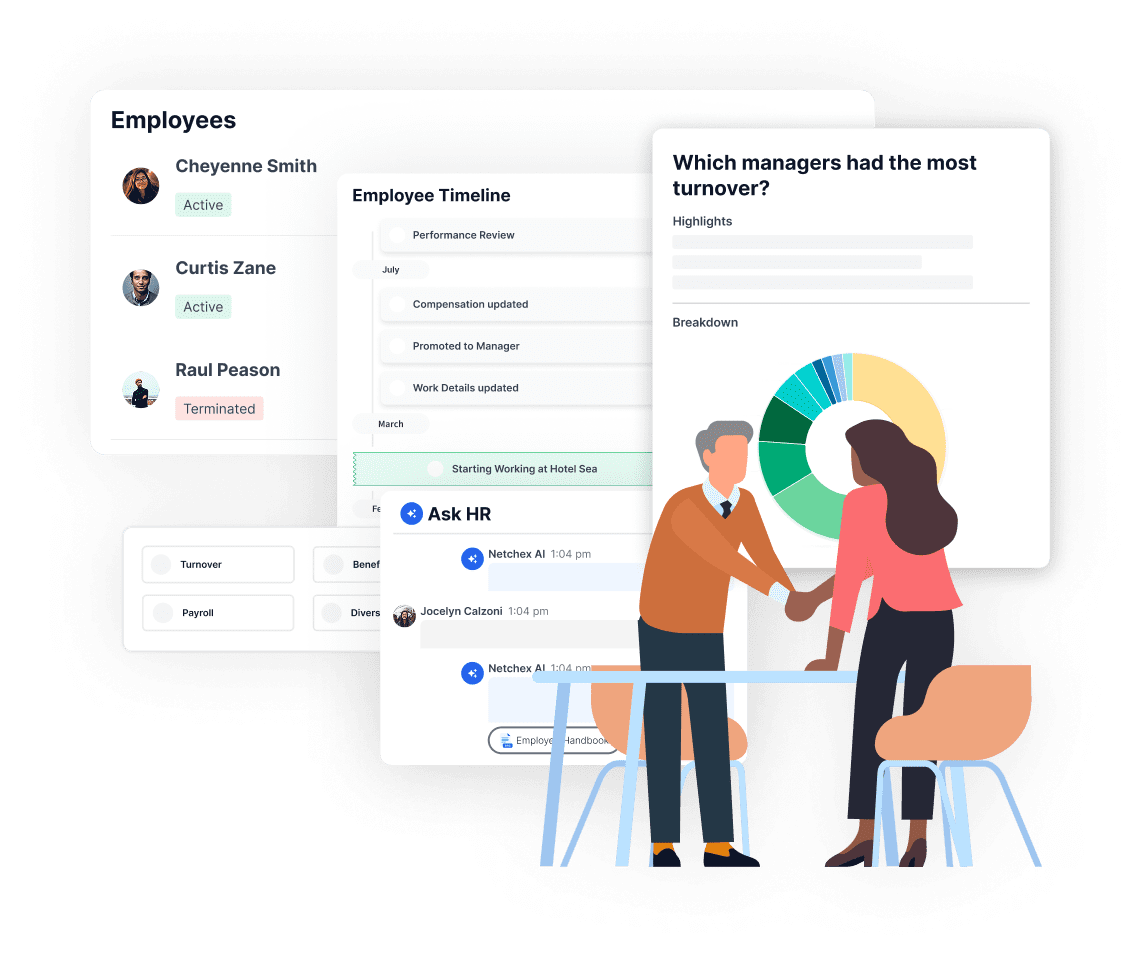
 HR
HR
All-in-One HR Software
One system. Every employee. No more platform juggling.
Manage your people, paperwork, and processes in one connected platform, no matter your industry, team size, or number of locations. Netchex HR delivers clarity, consistency, and confidence across your entire workforce.

7,500+ organizations trust Netchex
HR for Your Hourly & Salary Teams
Just Got Easier
Netchex HR is purpose-built for industries like yours.
All-in-One HR, Built for the Real World
From onboarding to offboarding and everything in between, Netchex HR brings together all the essentials:
- Centralized employee records and document management
- Policy management and digital handbooks with required acknowledgments
- License & certification management with expirations, renewals, and automated reminders
- Built-in compliance support and alerts for EEO, I‑9, ACA, and more
It’s all in one place and fully integrated with payroll, time, benefits, and performance.
Answers, Faster with AskHR AI
Stop fielding repetitive HR questions.
Netchex’s AskHR Assistant delivers instant, policy-based answers pulled from your company’s own documents, customized to match your HR team’s tone and brand.
So your team stays focused, not buried in FAQs.
Smarter HR Data. Stronger Business Results.
Netchex HR puts your data to work.
Track turnover, monitor compliance tasks, and evaluate policy effectiveness across teams or locations. Use built-in reporting and Insights dashboards to spot trends, stay compliant, and act with confidence.
Easy for Employees. Efficient for HR.
Whether employees are on the job, on the road, or reporting across multiple locations, Netchex HR keeps everything accessible.
- Intuitive self-service tools for profile updates and document downloads
- One-click Digital acknowledgments for handbooks and training
- Mobile-friendly access for every user, from admins to field staff
Explore Netchex HR Features
Document management
Store policies, forms, and acknowledgments in one place with version control and audit‑ready activity trails.
Licenses & certifications
Track credentials with effective/expiration dates and alerts, so renewals never slip through the cracks.
EEO & compliance reporting
Capture required demographics and generate EEO/VETS reports in a few clicks to stay audit‑ready.
Compensation benchmarking
See pay ranges by role and location and compare against benchmarks to support fair, compliant pay decisions.
Works with the tools you already use
DealerTrack & Netchex
Streamlines dealer operations to drive profit potential and improve efficiency.
Daxko Club Automation
Club Automation empowers fitness centers and health clubs to run smarter, more efficient operations.
Transamerica & Netchex
Transamerica is a financial services company offering a variety of retirement and insurance services, as well as annuities and investment management.

Hireology & Netchex
Hireology is a hiring and HR platform that empowers decentralized businesses to attract and retain talent.
Vestwell & Netchex
Access a modern platform and full-service solution to streamline your company’s retirement plan.
QuickBooks & Netchex
Easily connect their QuickBooks Online (QBO) account directly to Netchex payroll
Intuit & Netchex
Tax preparation services for seamless delivery of W-2 information and a streamlined the tax-filing process.
H&R Block & Netchex
Seamless delivery of W-2 information and a streamlined the tax-filing process.
Netchex Customer Testimonials
Payroll Specialist

“I love the integrated platform. With our old payroll company you would have to make the same change in several different areas of the software. With Netchex, it only takes once. This system is so user-friendly, it makes training a breeze. And the customer service is second to none!”
Payroll Administrator

Netchex has been fantastic. We enjoy personalized service, we know the people that we deal with, and they bend over backward to get what we need done.
HR Director

Netchex is wonderful. Everyone has been continuously impressed by the services they provide. Back when the new ACA regulations went into place, and even now with the whole COVID-19 situation, Netchex just continues to knock it out of the park
HR FAQs
Yes. You can store employee records, upload company policies, and require digital acknowledgments, all in one secure system.
Absolutely. Netchex is built for complex businesses. You can manage employees across multiple locations and departments and even separate companies from one account.
Netchex includes pre-built and customizable reports for turnover, headcount, compliance, document status, and more. Use dashboards or export data on demand.
Yes. Employees can access their profiles via desktop or mobile to update contact info, download documents, and review company policies without submitting requests to HR.
AskHR AI pulls directly from your policies and platform data to answer common employee questions instantly, reducing the day-to-day burden on your HR team.
Yes. Netchex includes built-in compliance tools, alerts, and secure audit trails to support your compliance with federal, state, and industry-specific regulations.
Smarter HR Starts Here
Modern HR. Mobile-ready. Backed by real support. With Netchex, you can finally trade HR chaos for clarity and get time back to focus on what really matters: your people.